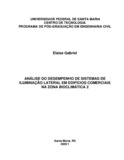| dc.creator | Gabriel, Elaise | |
| dc.date.accessioned | 2021-09-15T16:33:46Z | |
| dc.date.available | 2021-09-15T16:33:46Z | |
| dc.date.issued | 2020-03-03 | |
| dc.identifier.uri | http://repositorio.ufsm.br/handle/1/22225 | |
| dc.description.abstract | Numerous buildings have high rates of waste of electricity, as well as opportunities to save
energy by not considering bioclimatic, passive and / or active strategies. In commercial
buildings, daylight plays a major role because it is abundantly available during the
occupation hours of these buildings. However, artificial lighting is responsible for a large
portion of the energy consumption, mainly because these buildings do not make the
integrated use of both forms of lighting. The use of daylight, in addition to providing
appropriate illuminance levels for the performance of human activities, also reduces the
need for the use of artificial light, which can be efficiently controlled by lighting systems,
correct sizing of openings and use of shading devices, thus interfering with the building's
thermal gains and total energy consumption. This work aims to evaluate the thermal
performance of a commercial room, located at the Bioclimatic Zone 2, within the influence
of the integrated use of natural and artificial light with air conditioning, with different types
of glass and opening shading devices. The methodology was based on the evaluation and
comparison of the luminous and energetic performance of models with different variables,
through computational simulation in the DesignBuilder. The results showed that glasses
with VLT of 0.13 and 0.52 show a reduction in the levels of UDI with the use of shading,
whereas glasses with a higher VLT show an increase in the levels of UDI with the use of
brises. In addition, it was possible to identify the impact of using daylighting on total energy
consumption, through integrated simulations, about 79% savings by artificial lighting.
Another result was the use of shading devices, which allowed a reduction of up to 88.45%
in energy consumption by air conditioning. The use of artificial lighting system control
through sensors provided a reduction in energy consumption with artificial lighting as well
as influencing the thermal behavior of the air conditioner. This work allowed the incentive
for the inclusion of strategies to reduce consumption and improve the energy efficiency of
buildings. | eng |
| dc.description.sponsorship | Coordenação de Aperfeiçoamento de Pessoal de Nível Superior - CAPES | por |
| dc.language | por | por |
| dc.publisher | Universidade Federal de Santa Maria | por |
| dc.rights | Attribution-NonCommercial-NoDerivatives 4.0 International | * |
| dc.rights.uri | http://creativecommons.org/licenses/by-nc-nd/4.0/ | * |
| dc.subject | Iluminação natural | por |
| dc.subject | Iluminação artificial | por |
| dc.subject | Condicionamento de ar | por |
| dc.subject | Simulações termo-energéticas | por |
| dc.subject | Daylighting | eng |
| dc.subject | Artificial lighting | eng |
| dc.subject | Air conditioning | eng |
| dc.subject | Thermo-energetic simulations | eng |
| dc.title | Análise do desempenho de sistemas de iluminação lateral em edifícios comerciais na zona bioclimática 2 | por |
| dc.title.alternative | Analysis of the performance of side lighting systems in commercial buildings in the bioclimatic zone 2 | eng |
| dc.type | Dissertação | por |
| dc.description.resumo | Nas edificações comerciais, a luz natural possui grande importância por estar
abundantemente disponível durante os horários de ocupação desses edifícios. Todavia,
a iluminação artificial dos ambientes é responsável por grande parte do consumo
energético, principalmente por essas edificações não fazerem o uso integrado de ambas
formas de iluminação. O uso da luz natural, além de proporcionar níveis apropriados para
a realização das atividades humanas, reduz a necessidade do uso da luz artificial, que
pode ser controlada de forma eficiente por meio de sistemas de iluminação,
dimensionamento correto de aberturas e uso de dispositivos de sombreamento,
interferindo também, nos ganhos térmicos da edificação e no consumo total de energia.
Este trabalho tem como objetivo avaliar o desempenho térmico de uma sala comercial,
localizada na zona bioclimática 2, a partir da influência da utilização integrada de luz
natural e artificial com condicionamento de ar, com diferentes tipologias de vidros e
dispositivos de sombreamento de aberturas. A metodologia foi baseada na avaliação e
comparação do desempenho lumínico e energético de modelos com diferentes variáveis,
por meio da simulação computacional no programa DesignBuilder. Os resultados
mostraram que vidros com Transmissão de Luz Visível (TV) de 0,13 e 0,52 apresentam
redução dos níveis de iluminância úteis (UDI) com a utilização de sombreamento, já
vidros com TV mais elevado apresentam aumento dos níveis de UDI com a utilização de
brises. Além disso, foi possível identificar o impacto do aproveitamento da iluminação
natural no consumo energético total, por meio das simulações integradas, cerca de 79%
de economia por iluminação artificial. Um outro resultado foi a utilização dos dispositivos
de sombreamento, que possibilitaram a diminuição de até 88,45% no consumo de
energia por ar condicionado. O uso do controle do sistema de iluminação artificial por
meio de sensores proporcionou uma redução no consumo de energia com iluminação
artificial além de influenciar o comportamento térmico do ar condicionado. Este trabalho
possibilita o incentivo para a inclusão de estratégias de redução de consumo e melhoria
da eficiência energética de edificações. | por |
| dc.contributor.advisor1 | Grigoletti, Giane de Campos | |
| dc.contributor.advisor1Lattes | http://lattes.cnpq.br/9725292275606192 | por |
| dc.contributor.referee1 | Scherer, Minéia Johann | |
| dc.contributor.referee2 | Cunha, Eduardo Grala da | |
| dc.creator.Lattes | http://lattes.cnpq.br/5647891789557591 | por |
| dc.publisher.country | Brasil | por |
| dc.publisher.department | Engenharia Civil | por |
| dc.publisher.initials | UFSM | por |
| dc.publisher.program | Programa de Pós-Graduação em Engenharia Civil | por |
| dc.subject.cnpq | CNPQ::ENGENHARIAS::ENGENHARIA CIVIL | por |
| dc.publisher.unidade | Centro de Tecnologia | por |



